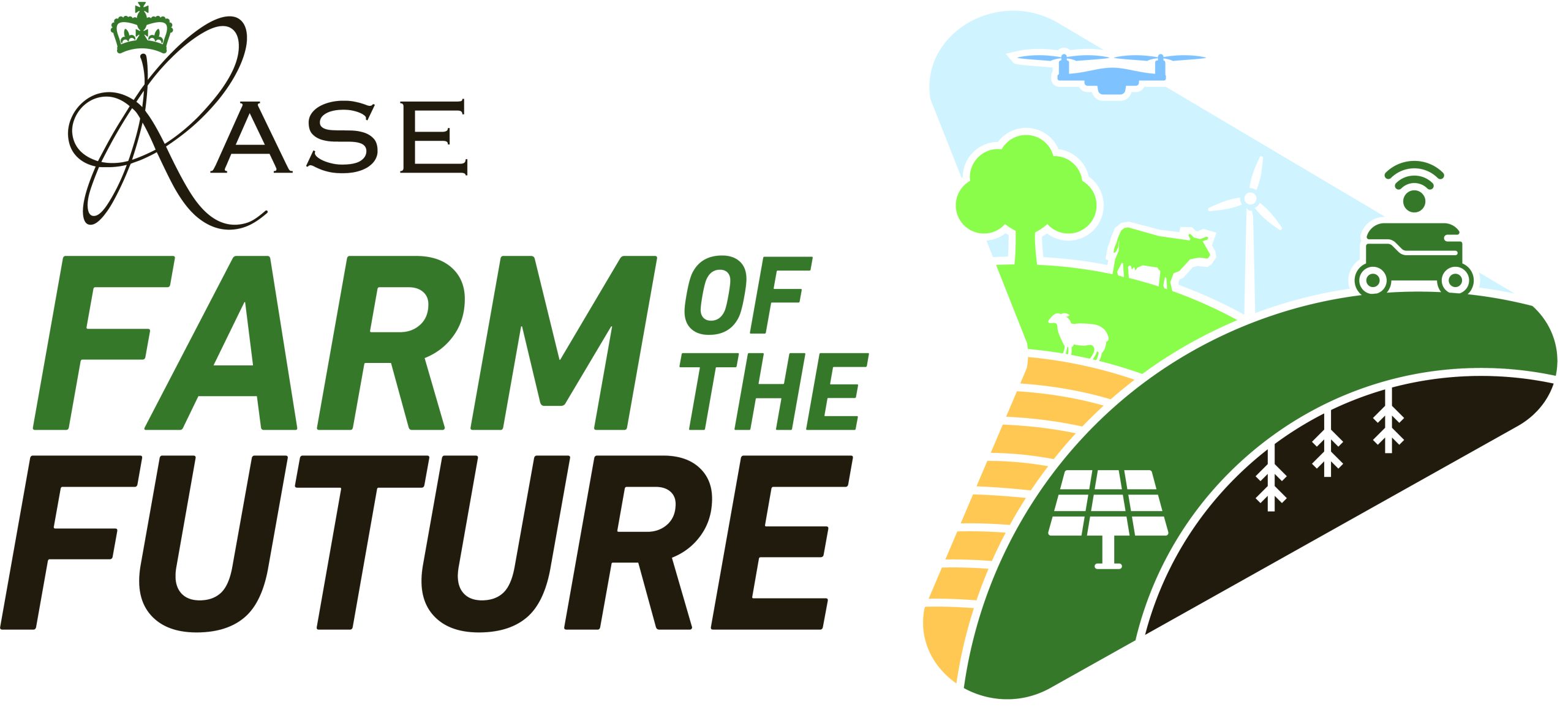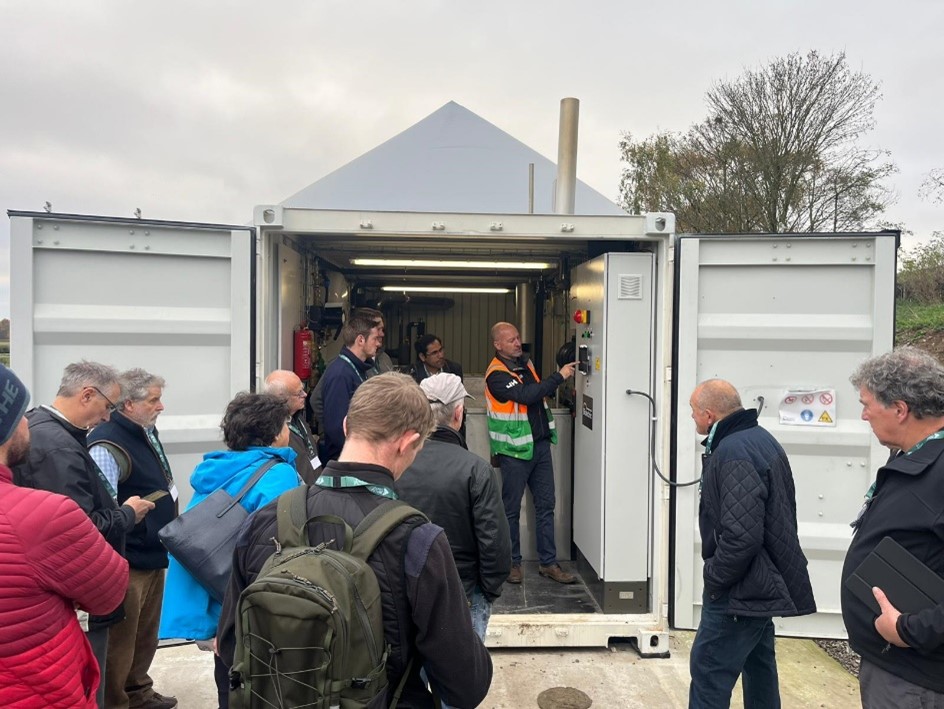As decarbonisation and removing fossil fuels from the food system creep higher up the socio-political agenda, the agricultural industry must start planning for what will fuel agriculture post red diesel.
To start the conversation, RASE and Yorkshire Agricultural Society co-hosted an event at Askham Bryan College in October 2024, which looked at the future of fuels in agriculture. View the event highlights video here or read on to find out more about what was covered.
The tour of the ‘Electric Cow’ and demonstrations
The event began with a tour of Askham Bryan’s anaerobic digestion (AD) plant, dubbed the ‘electric cow’. Attendees were able to see how the college processes its slurry to produce biogas. The biogas is then used to produce electricity and heat, which helps the farm become a more self-sustaining system. The process of AD – breaking down organic material in the absence of oxygen – also reduces the farm’s methane emissions, as well as producing the final digestate material which is used as fertiliser. This set the scene perfectly for the event as it provided the opportunity to see the subject of the talks in action, and brought everything into context.
The event also demonstrated the effectiveness of hydrogen as a fuel, with a lighting rig powered by bottled hydrogen. The fuel will power the lights for 240 hours.
Mixed into the talks were examples of New Holland’s methane tractor and JCB’s range of hydrogen vehicles. Both grounded the event in its context, understanding how producing biofuels on farm can create a more resilient and cost-efficient system in the future, as the risks of volatile international oil prices are removed. These vehicles could play an important role in reducing the carbon footprint of agriculture and it was great to have these examples shown to see that even if they are not the perfect solution for every farmer today, there are a growing number of options available when we think of future fuels in farming.
Setting the scene for alternative fuels
AD and hydrogen are becoming increasingly focused on both outside of and in agriculture. Lewis Kirkwood from Northern Gas Network (NGN) gave an overview of how existing gas infrastructure is being adapted to connect biofuel production to the grid and transport hydrogen around the country. One of the main uses for natural gas at the moment is in large greenhouses, therefore there was an interest from NGN to connect with farmers, particularly with the potential for increased biogas production going forward.
Lucy Hopwood from NNFCC illustrated the increases in biogas production from farms and where there is potential financial support from government in the establishment of projects. She also showed that currently only 50% of crop residues and 3% of livestock waste is being used to produce biogas, therefore there is huge potential for growth in the industry on farms.
The farm as the energy centre of the village
Jonathan Hind from SY Ecofit invited us to start making ‘islands of power’ on farms. Because farmers have frequently come up against issues when trying to connect large renewable power projects to the grid (this varies by region and energy supply company), Jonathan spoke about how farms can use renewable energy production to provide electricity to power an electrolyser to create hydrogen fuel. He suggested that with an efficient solar, wind and AD system working together to produce hydrogen a farm could reduce 90% of their emissions, and be able to produce all of the power they need almost all year round.
Mike Kaye from Energy Oasis went a step further, although not far beyond the farm gate, to suggest that this hydrogen produced could be sold to people in neighbouring villages to fuel their cars. He made a compelling case for not only making the farm more self-sufficient, but to also then create a surplus of hydrogen that can be sold (that is, if enough of their neighbours also have hydrogen vehicles). Although it seemed like a daunting step, and would require huge investment in infrastructure, it was pleasing to imagine a future where farms were very much back in the village centre, powering their local communities, and all with a ‘green’ fuel.
Issues such as planning were discussed as it can often take 18 months to 2 years to gain planning permission, therefore it is worth starting to investigate the potentials of AD and hydrogen early, so that the project does not become too delayed.
From anaerobic digestion to hydrogen
Deborah Rathbone presented research from the Biorenewables Development Centre, and this exciting work could make hydrogen production on farm much more accessible. Dark fermentation is a process similar to AD, however the process is halted earlier (meaning that it can take only a few days rather than weeks) and algae and cyanobacteria are added, resulting in hydrogen being the final product, rather than methane. This prevents the need for large scale renewable energy installations (or otherwise huge energy bills) to power an electrolyser, however it is still in its early stages of development.
Bringing everything back to the farm
The event closed with Will Raw, a farmer from Yorkshire discussing the actions he has already taken on farm, partly through the NFU’s Energy Project, as well as some of his takeaways from the day. Will did state that he would be now going away considering hydrogen on the farm – some very positive feedback for our speakers – as he acknowledged the current challenges with installing other renewable energy systems, such as difficulty becoming connected to the grid or low return on investment for battery storage. Away from AD and hydrogen Will had already made big steps to lower his farm’s environmental impact, such as installing LEDs; insulating sheds; installing solar panels on roofs and creating more circular systems between his livestock and arable enterprises. Will gave the important reminder that for ideas to be effective they have to work well and fit into the farm system easily, not just be a great idea on paper.
Questions from the audience
There was a wide range of questions from the audience, however many touched upon the logistics and feasibility of installing biogas infrastructure. The answers to questions about overcoming issues with grid connection and improving policy to make the installation of new projects more accessible were fairly uncertain, as they involve the need of top-down decision making from large actors. However, if interest in biogas continues to grow, we can hope that it becomes a larger part of the conversation in both agricultural and energy policy.
There was also a discussion around the wider hydrogen supply chain, and the traceability of hydrogen to know if we are using green, blue or brown hydrogen. Whilst green hydrogen is seen as a sustainable fuel with no carbon emissions, brown hydrogen comes from the burning of coal. In wider supply chains, there may be difficulties tracing how the hydrogen was produced, and therefore it may not be quite as ‘green’ as we hope it will be. This is something that would have to be considered if hydrogen use increased in the UK. Of course, for closed system on farm, this would not be an issue as the source of the gas will always be known.
If the energy of the room at Askham Bryan is anything to go by, it seems that there is an emerging space for biogas production and utilisation on farm. There are a few caveats that cannot be ignored, such as the patchy policy, large upfront investment and currently a limited market for using biogas fuels, however the possibilities of the fuel for maintaining agricultural productivity whilst reducing greenhouse gas emissions is encouraging and supports the need for more research and development in the area. Fuel use in agriculture will only continue to grow in importance as a topic as we come closer to exhausting oil supplies, therefore to see that there are already some potential – even if not perfect – solutions emerging is incredibly promising.

